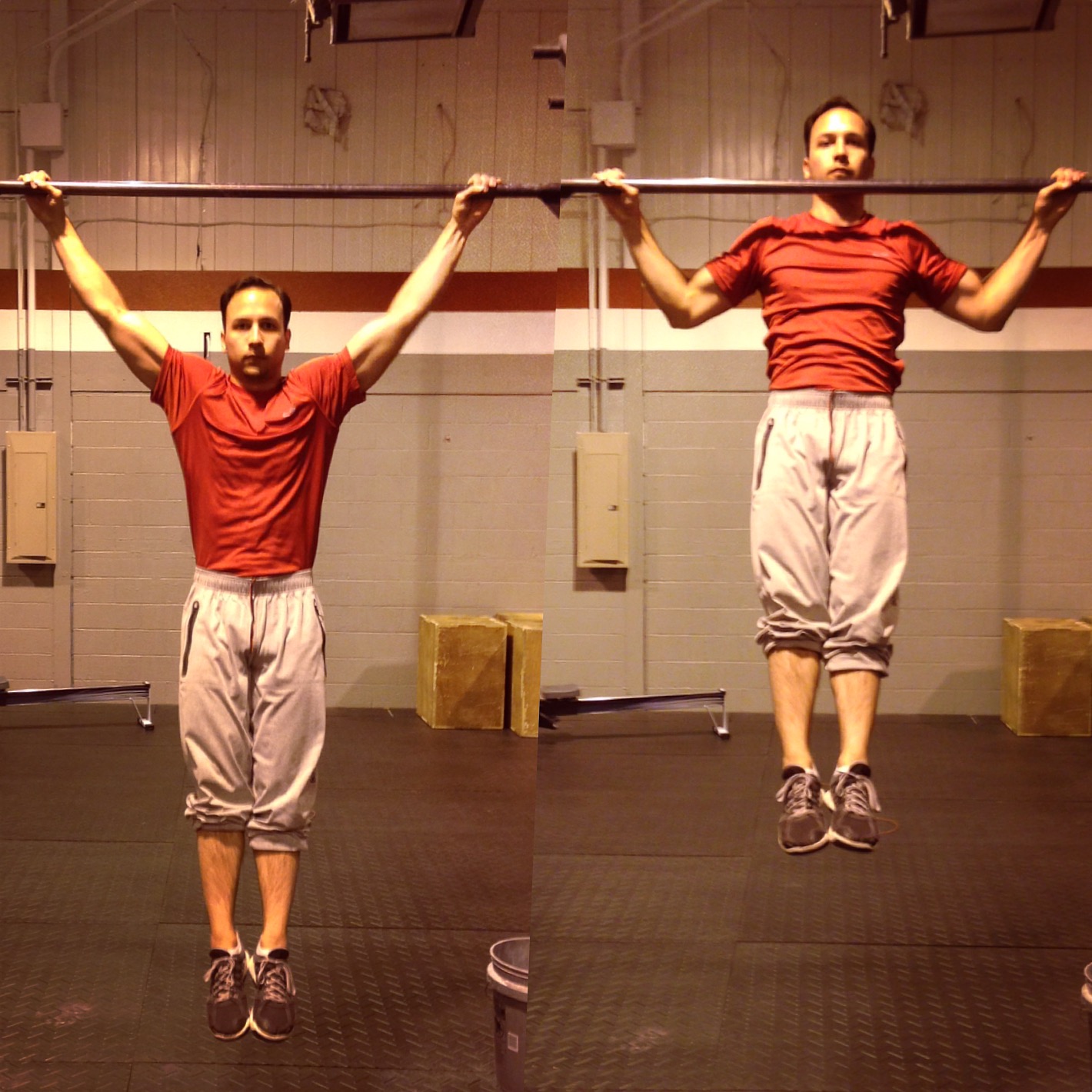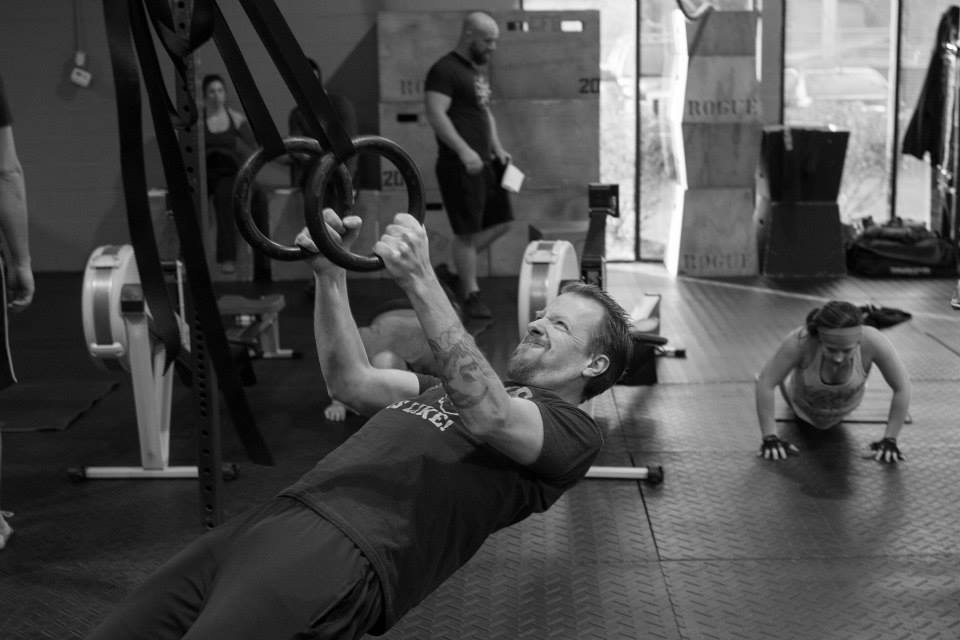Can I learn to kip?
With the inclusion of toes to bar and chest to bar in the first two 2015 Open workouts, this question has come up a lot recently. Unless you can do strict pull-ups, the answer is no.

Ian, our resident strict pull-up master
When I began CrossFit 3 years ago, I learnt to kip early on. I was doing kipping pull-ups in WODs 18 months before I could do one strict pull-up. You know what happened? Pretty quickly I was suffering from shoulder impingement, which is frustrating, painful and can lead to serious problems.
The kipping pull-up was popularized by the sport of CrossFit as a faster way to do a regular pull-up. Competitors that started using the kip were strong enough and had the shoulder mobility to do so safely. As CrossFit gained popularity, the kipping pull-up began to be used inappropriately. Everyone wants to write a fast time on the whiteboard, so beginners began learning to kip before they could do a single strict pull-up. More recently, there has been backlash against its early introduction. Coaches and athletes have learnt, sometimes the hard way, that it is essential to develop a base of strength and mobility before trying to introduce the kipping pull-up.
Here we see strict pull-ups, kipping pull-ups, then butterfly pull-ups
Quickly, let’s address the idea that the kipping pull-up is ‘cheating’. If you haven’t mastered strict pull-ups, I’d agree that yes, it is, because you are cheating yourself of long-term results and the health of your shoulders. If strict pull-ups are no issue for you, then kipping pull-ups have their place. Kipping is a powerful, fast, core to extremity motor recruitment pattern, adding a higher power average output to workouts than strict pull-ups would. If we did Fran with strict pull-ups, our time would be significantly slower and we would lose the intensity of the workout. Kipping requires coordination, agility and mobility. When done properly, it is a highly technical movement.
Kipping movements are fast and explosive, which is why we use them in timed WODs. When you have the strength to do strict pull ups, your kip will be smaller and more controlled. You will have be able to maintain tension on the descent and there will be no jarring moment as the arms extend at the bottom. The movement will not only be safer, but faster too. When someone does not have the strength to pull their bodyweight over the bar, they often resort to wild, uncontrolled kips to get their chin over the bar.
The down phase of the movement is what is most problematic. If you are not strong enough to pull just your bodyweight, do you think your shoulders should be absorbing your bodyweight, plus the downward momentum, plus the forward momentum as you prepare for the next big swing? Additionally, coming to the end of your shoulder’s range as you pull yourself in front of the bar at the bottom can be a highly unstable and risky position if not executed with extreme control. Done over and over again in high repetition workouts, eventually something will go wrong.
If you have the strength to do strict, dead hang pull-ups, and the shoulder stability that this affords, a controlled kip is fine. But not all the time. The kip serves a unique purpose, but it is not a replacement for the strict pull-up.
A quick note on the butterfly pull-up. I agree with Greg Everrett when he states that unless you’re a Games or competitive athlete, you should not regularly use the butterfly pull-up. The potential for injury here is much higher than with a regular kip and it requires much more strength. The ‘free-fall’ moment as the athlete comes forward to open the shoulders completely under the bar can be incredibly jarring.
When should the kip be introduced?
Until you are able to do 5 strict pull-ups, you should not try to kip. Use the rings, do negatives, use a band or do jumping pull-ups. You can even get a friend to spot you and give you a little extra push. I know it takes longer and strict pull-ups are hard! Labral tears are worse.
Let’s talk about how to get the most out of pull-up progressions in a little more detail. Persevere and consider it a long-term investment.
Active Hangs: Practice hanging on the bar to build shoulder stability and grip strength. Don’t let your shoulders come up to your ears. Pull them down and retract the shoulder blades (pinch them together). Hold for as long as you can maintain the correct shoulder position.
Ring Rows: They are really hard when done correctly and will get you closer to that pull-up. Get as low under rings as you can- the more horizontal you are, the more difficult. For more advanced, feet on a box. Keep the body in a straight line (abs and butt tight) and don’t use the hips to ‘kip.’ When your arms are straight, push the shoulders down and together. Retract the shoulders as you pull and keep your head neutral. As you lower back, don’t let the shoulders roll forward. Keep them pinned back and down the entire time.
Jumping Pull-Ups: The box should be set up so that when you stand on it and straighten your arms, the bar should rest between your wrist and elbow (closer to the wrist is harder). As you initiate the movement, begin with a pull from the arms and only finish the pull-up with a little push from the legs, as small as possible. The feet are only back up, if you are using a big jump you will never progress with these.
Band Pull-Ups: Bands can be useful, or terrible. I don’t mind if people use them, but with conditions. They should only be used for strict pull-ups, never for kipping, and you must take care not to bounce out of the bottom. If you have to use two extra thick bands, stick to ring rows. When you get on the rig with your foot in a light band, dead hang then active hang before you start to pull. With no downwards or forwards motion, slowly pull your chin over the bar, then lower 3-2-1. Pause at the bottom, then activate the shoulders and lats before you begin to pull again.
Negatives: I like these the most, particularly as you get close to that strict pull-up. Use a little jump to get your chin over the bar, and then slowly as you can, lower yourself until your arms are straight. Keep it controlled and try not to jar, particularly towards the end of the movement.
You might be moving a little slower for a while, but the only way to progress to a safe and efficient kipping pull-up is to develop the strict. If you know this is something you need to work on, I suggest lowering the number of reps in a pull-up WOD and taking the time to practice a challenging option that will help you achieve your goal, rather than racing through jumping pull-ups. Practice your pull-ups outside of WODs too, when you don’t have the pressure of the clock. Come in early one or two days a week and spend 10 minutes on them.
Kipping pull-ups can be a useful, mechanically sound movement and I absolutely will teach you how to do them, but strict comes first.









































